2019-12-12 - Nº 241
Editorial
Esta é a Newsletter Nº 241 que se apresenta com o mesmo formato que as anteriores. Se gostar da Newsletter partilhe-a!
Todas as Newsletters encontram-se indexadas no link.
Esta Newsletter tem os seguintes tópicos:
Faz hoje anos que nascia, em 1774 - William Henry. Este Médico e químico inglês, em 1803, propôs a chamada lei de Henry, que afirma que a massa de um gás dissolvido por um determinado volume de solvente, a uma temperatura constante, é directamente proporcional à pressão do gás acima do líquido, desde que nenhuma ação química ocorra. A lei vale apenas para gases levemente solúveis a baixa pressão. Henry era amigo íntimo de John Dalton, mas, apesar das habilidades e alcance superiores como experimentador, não possuía a ousadia de Dalton como teórico, e Henry nunca se comprometeu com a teoria atómica.
Faz também hoje anos que nascia, em 1846, Eugen Baumann. Este químico alemão descobriu que a glândula tiróide era rica em iodo, um elemento antes desconhecido que ocorre naturalmente no tecido animal, tornando a glândula tiróide única por ser o único tecido a conter iodo. Isto levou à descoberta da hormona da tiróide contendo iodo e ao seu tratamento em distúrbios da tiróide.
Faz igualmente hoje anos que nascia, em 1866, Alfred Werner. Este químico suíço ficou conhecido pela sua pesquisa inicial sobre a estrutura dos compostos de coordenação e deu-lhe o Prémio Nobel de Química de 1913. Ele demonstrou que a estereo-química não era apenas propriedade dos compostos de carbono, mas era geral para toda a química. A sua teoria da coordenação química (1893) reconheceu que muitos metais pareciam mostrar valência variável e formar compostos complexos. Certos metais, como o cobalto e a platina, foram capazes, por meio das suas valências secundárias, de se unirem a um certo número de átomos ou moléculas. Estes foram denominados por "compostos de coordenação" de Werner e o número máximo de átomos (ou "ligantes", como ele os chamava) que podem ser unidos ao metal central é o seu número de coordenação.
Faz também hoje anos que nascia, em 1900, Mária Telkes. Esta física húngaro-americana foi pioneira na aplicação de energia solar à destilação de água e aquecimento doméstico. Ela imigrou para os EUA em 1925, trabalhou como biofísica (1926-37) e naturalizou-se em 1937. Como consultora civil do Escritório de Pesquisa e Desenvolvimento Científico dos EUA durante a Segunda Guerra Mundial, ela elaborou um sistema de destilação de água aquecida por energia solar para tornar a água do mar potável. No final da década de 1940, ela projectou um sistema de armazenamento químico de energia solar para a primeira casa com aquecimento solar, um projecto do MIT construído em Dover, Massachusetts. Ela desenvolveu um fogão movido a energia solar e, na década de 1970, experimentou um sistema de ar condicionado que armazenava o ar fresco da noite para uso durante o calor do dia seguinte.
Por fim, faz anos hoje que nascia, em 1927, Robert Noyce. Este engenheiro e inventor americano que, com Jack Kilby foram responsáveis pela invenção do circuito integrado, um sistema de transístores interligados num único micro-chip de silício. Em 1957 co-fundou a Fairchild Semiconductor. Em 1968, ele e seu colega Gordon E. Moore foram co-fundadores da N.M. Electronics, que mais tarde seria renomeada para Intel Corporation.
Nesta semana que passou a Harbor Air e magniX anunciam o primeiro voo bem-sucedido do primeiro avião elétrico comercial do mundo. O voo bem-sucedido do ePlane, um DHC-2 de Havilland Beaver para seis passageiros, equipado com um sistema de propulsão magni500 de 750 cavalos de potência (560 kW), ocorreu no rio Fraser no terminal da Harbor Air Seaplanes em Richmond (YVR South). O avião foi pilotado pelo CEO e fundador da Harbor Air, Greg McDougall. Este vôo histórico significa o início da terceira era na aviação - a era da eletricidade.
Também nesta semana que passou a Blue Origin lançou com sucesso a missão New Shepherd. Esta missão foi mais um passo no sentido de verificar que o New Shepard está preparado para voos espaciais humanos, à medida que continua a ser amadurecida a segurança e a confiança do veículo. Este foi o sexto voo para este veículo New Shepard em particular. A Blue Origin até agora reutilizou dois boosters cinco vezes cada um consecutivamente, sendo que hoje marca um recorde com este booster a completar o seu sexto voo para o espaço e de volta.
Na Newsletter desta semana apresentamos diversos projetos de maker assim como alguns modelos 3D úteis. É apresentado o Livro "Earth at Night" pela NASA.
 João Alves ([email protected])
João Alves ([email protected])
O conteúdo da Newsletter encontra-se sob a licença  Creative Commons Attribution-NonCommercial-ShareAlike 4.0 International License.
Creative Commons Attribution-NonCommercial-ShareAlike 4.0 International License.
Novidades da Semana

Harbour Air and magniX Announce Successful Flight of World’s First Commercial Electric Airplane
"Harbour Air, North America’s largest seaplane airline and magniX, the company powering the electric aviation revolution, today announced the successful flight of the world’s first all-electric commercial aircraft. The successful flight of the ePlane, a six-passenger DHC-2 de Havilland Beaver magnified by a 750-horsepower (560 kW) magni500 propulsion system, took place on the Fraser River at Harbour Air Seaplanes terminal in Richmond (YVR South) this morning. The plane was piloted by Harbour Air CEO and founder Greg McDougall. This historic flight signifies the start of the third era in aviation – the electric age. “Today, we made history,” said Greg McDougall, CEO and founder of Harbour Air Seaplanes. “I am incredibly proud of Harbour Air’s leadership role in re-defining safety and innovation in the aviation and seaplane industry." [...]

New Shepard Mission NS-12 Updates
"New Shepard had a wholly successful mission on December 11, 2019. This mission was another step towards verifying New Shepard for human spaceflight as we continue to mature the safety and reliability of the vehicle. This was the 6th flight for this particular New Shepard vehicle. Blue Origin has so far reused two boosters five times each consecutively, so today marks a record with this booster completing its 6th flight to space and back. This particular rocket has been an operational payload vehicle for several flights, meaning there are no more updates to the system. This was also the 9th commercial payload mission for New Shepard, and we are proud to be have flown our 100th customer on board." [...]
Outras Notícias
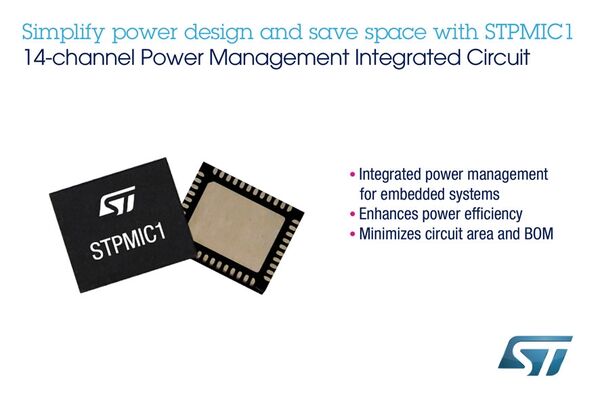
Fully Integrated Power-Management IC from STMicroelectronics Saves Board Space, Bill of Materials, and Power Consumption
"With features including four DC/DC buck converters, a boost DC/DC converter, and six low-dropout regulators (LDOs), the STMicroelectronics STPMIC1 power-management IC (PMIC) satisfies the complex power demands of highly integrated application-processor based systems. The chip is optimized as a companion PMIC for ST’s STM32MP1* heterogeneous multicore microprocessors, which target a broad range of applications by integrating single or dual Arm® Cortex®-A7 and Cortex-M4 cores, an optional 3D graphics processing unit, and rich digital and analog peripherals. More than simply saving board space and BOM cost, compared to arranging the same number of power rails using discrete components, the STPMIC1 also provides power-rail monitoring and protection, handles power-up/down sequencing, and meets the ST32MP1 accuracy and settling-time specifications. ST Authorized Partner Octavo Systems has utilized the STM32MP1 and STPMIC1 to create the OSD32MP1x family of microprocessor system-in-package (SiP) devices, which occupy a footprint up to 64% smaller than an equivalent system implemented with discrete components while also addressing engineering challenges such as power sequencing. Greg Sheridan, VP of Strategy at Octavo Systems commented, “The STPMIC1 is the perfect power-management solution for the OSD32MP1x family of system-in-package devices. With a single power input and 14 output rails including a 5V boost, it provides all the power needed for the STM32MP1 microprocessor while still providing plenty of options to power the rest of the system giving our SiP, which is packed in a tiny 18mm x 18mm package, the flexibility to support a wide range of applications.” In addition to supplying power rails for the microprocessor unit (MPU) and external system components, the STPMIC1 also provides a DDR memory reference voltage, a 500mA USB OTG power switch, and a general-purpose power switch." [...]
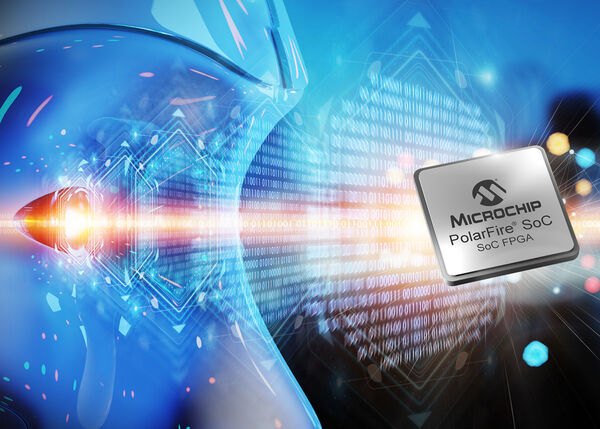
Microchip Unveils Family Details and Opens Early Access Program for RISC-V Enabled Low-Power PolarFire SoC FPGA Family
"Early access program starts for PolarFire SoC, which delivers simultaneous support of real-time applications and rich operating systems with unparalleled power efficiency The trend towards compute intensive gateways and edge devices is driving the integration of traditional deterministic control applications with additional embedded processing capabilities needed for smart and secure connected systems. In response, Microchip Technology Inc. (Nasdaq: MCHP) is opening the Early Access Program (EAP) for the PolarFire® system-on-chip (SoC) field programmable gate array (FPGA). The platform offers the world’s first hardened real-time, Linux® capable, RISC-V-based microprocessor subsystem on the award-winning, mid-range PolarFire FPGA family, bringing class-leading low power consumption, thermal efficiency and defense grade security to embedded systems. Qualified EAP customers can start designing now with Microchip’s Libero® SoC 12.3 FPGA design suite and SoftConsole 6.2 integrated development environment for the embedded developer. Customers can also debug their embedded applications today using Renode, a virtual model of the microprocessor subsystem. “Delivering the industry’s first RISC-V based SoC FPGA along with our Mi-V ecosystem, Microchip and its Mi-V partners are driving innovation in the embedded space, giving designers the ability to develop a whole new class of power-efficient applications,” said Bruce Weyer, vice president of the Field Programmable Gate Array business unit at Microchip." [...]

TSMC on track to start 3nm production in 2022
"TSMC has been fast advancing its manufacturing processes. It is on track to move 5nm node to commercial production in the second half of 2020, and will soon break ground for a 3nm facility where volume production will start in 2022. Next year promises to be a fruitful one thanks to 5G picking up momentum, but in the meantime, Taiwanese IC desingers see orders slow down from Chinese clients who are conducting year-end inventory checks. But phone vendors are set to launch more 5G devices in 2020, including foldable ones. But vendors of such foldable phones have to make sure they receive sufficient supply for OLED panels. TSMC to kick off 3nm process manufacturing in 2022: TSMC is firmly on track to move 5nm process technology to commercial production in the first half of 2020 and will kick off production of chips built using a newer 3nm process node in 2022, according to JK Wang, the firm's senior vice president for fab operations." [...]

NRL-camera aboard NASA spacecraft confirms asteroid phenomenon
"A U.S. Naval Research Laboratory-built camera mounted on the NASA Parker Solar Probe revealed an asteroid dust trail that has eluded astronomers for decades. Karl Battams, a computational scientist in NRL’s Space Science Division, discussed the results from the camera called Wide-Field Imager for Solar Probe (WISPR) on Dec. 11 during a NASA press conference. WISPR enabled researchers to identify the dust cloud trailing the orbit of the asteroid 3200 Phaethon. “This is why NRL’s heliospheric imagers are so ground-breaking,” Battams said. “They allow you to see near-Sun outflows massively fainter than the Sun itself, which would otherwise blind our cameras." [...]
ICON Unveils the World’s First Village of Affordable 3D-Printed Homes in Mexico
"After 18 months of planning, ICON and New Story just unveiled two affordable 3D-printed homes in a groundbreaking development for Tabasco, Mexico. In Tabasco, Mexico, a family living below the poverty line recently visited their future home: a 3D-printed, 500-square foot structure with two bedrooms, one bath, a wraparound cement patio, and an awning over the front porch. With an off-white exterior complimented by breeze blocks, the dwelling is earthen, compact, and even stylish. It’s one of two fully furnished homes—printed in about 24 hours and finished by local nonprofit ÉCHALE—that will soon make up a larger community of 50 dwellings with green spaces, parks, amenities, and basic utilities. Tabasco is a seismic zone, so the homes were engineered beyond standard safety requirements—and they’ll endure for generations. Through the development and design process, families selected to live in the new community—ones in utmost need—provided feedback to create homes that would best suit their lifestyles." [...]
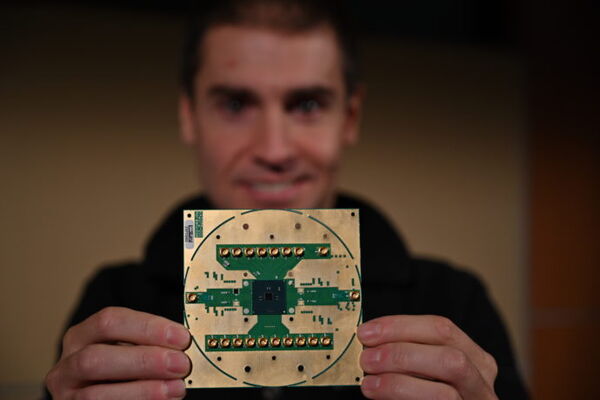
Intel Introduces ‘Horse Ridge’ to Enable Commercially Viable Quantum Computers
"Intel Labs today unveiled what is believed to be a first-of-its-kind cryogenic control chip — code-named “Horse Ridge” — that will speed up development of full-stack quantum computing systems. Horse Ridge will enable control of multiple quantum bits (qubits) and set a clear path toward scaling larger systems — a major milestone on the path to quantum practicality. Developed together with Intel’s research collaborators at QuTech, a partnership between TU Delft and TNO (Netherlands Organization for Applied Scientific Research), Horse Ridge is fabricated using Intel’s 22nm FinFET technology. In-house fabrication of these control chips at Intel will dramatically accelerate the company’s ability to design, test and optimize a commercially viable quantum computer. “While there has been a lot of emphasis on the qubits themselves, the ability to control many qubits at the same time had been a challenge for the industry. Intel recognized that quantum controls were an essential piece of the puzzle we needed to solve in order to develop a large-scale commercial quantum system." [...]
Ciência e Tecnologia
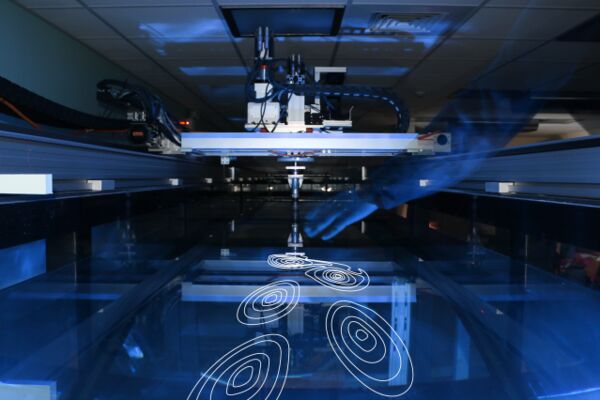
Intelligent Towing Tank propels human-robot-computer research
"A novel experimental facility integrates automation and active learning, illuminating a path to accelerated scientific discovery. In its first year of operation, the Intelligent Towing Tank (ITT) conducted about 100,000 total experiments, essentially completing the equivalent of a PhD student’s five years’ worth of experiments in a matter of weeks. The automated experimental facility, developed in the MIT Sea Grant Hydrodynamics Laboratory, automatically and adaptively performs, analyzes, and designs experiments exploring vortex-induced vibrations (VIVs). Important for engineering offshore ocean structures like marine drilling risers that connect underwater oil wells to the surface, VIVs remain somewhat of a phenomenon to researchers due to the high number of parameters involved. Guided by active learning, the ITT conducts series of experiments wherein the parameters of each next experiment are selected by a computer. Using an “explore-and-exploit” methodology, the system dramatically reduces the number of experiments required to explore and map the complex forces governing VIVs." [...]

MIT researchers realize “ideal” kagome metal electronic structure
"Newly synthesized compound of iron and tin atoms in 1-to-1 ratio displays unique behavior. Since 2016, a team of MIT researchers consisting of graduate students Linda Ye and Min Gu Kang, associate professor of physics Joseph G. Checkelsky, and Class of 1947 Career Development Assistant Professor of Physics Riccardo Comin has focused on exploring the electronic structure that arises when atoms of iron (Fe) and tin (Sn) combine in repeating patterns that look like Japanese kagome baskets, or the Star of David. The electronic behavior of these crystalline “kagome” structures varies with the ratio of iron to tin atoms, usually 3-to-2 or 3-to-1. Last year, the MIT team members and their colleagues reported that Fe3Sn2, a compound with a 3-to-2 ratio of iron to tin, generates Dirac fermions — a special kind of electronic state in which the spin of the electron and the orbit of the electron are coupled to each other. This special state of electron movement is protected by the topology, or geometric structure, of the crystal. Iron-tin compounds are of particular interest because the natural magnetism of iron atoms further affects their electronic behavior, in particular causing the spins of neighboring electrons to alternate in opposite directions (clockwise or counterclockwise), which is called antiferromagnetism." [...]

Reorganizing a computer chip: Transistors can now both process and store information
"Researchers solve decades-old challenge of building a functional transistor integrated with ferroelectric RAM A computer chip processes and stores information using two different devices. If engineers could combine these devices into one or put them next to each other, then there would be more space on a chip, making it faster and more powerful. Purdue University engineers have developed a way that the millions of tiny switches used to process information – called transistors – could also store that information as one device. The method, detailed in a paper published in Nature Electronics, accomplishes this by solving another problem: combining a transistor with higher-performing memory technology than is used in most computers, called ferroelectric RAM. Researchers have been trying for decades to integrate the two, but issues happen at the interface between a ferroelectric material and silicon, the semiconductor material that makes up transistors. Instead, ferroelectric RAM operates as a separate unit on-chip, limiting its potential to make computing much more efficient." [...]
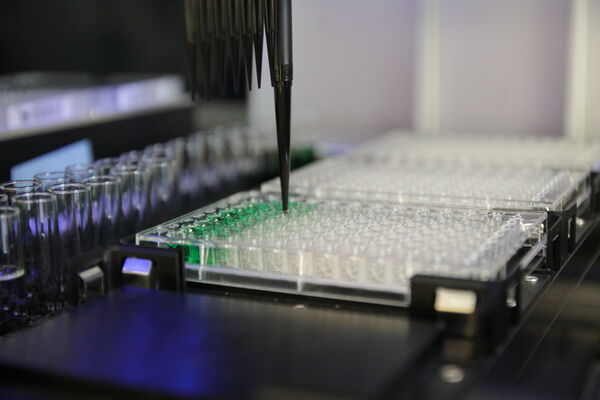
A Robot and Software Make It Easier to Create Advanced Materials
"Rutgers-led team pioneers automated way to make unique materials with polymers A Rutgers-led team of engineers has developed an automated way to produce polymers, making it much easier to create advanced materials aimed at improving human health. The innovation is a critical step in pushing the limits for researchers who want to explore large libraries of polymers, including plastics and fibers, for chemical and biological applications such as drugs and regenerative medicine through tissue engineering. While a human researcher may be able to make a few polymers a day, the new automated system – featuring custom software and a liquid-handling robot – can create up to 384 different polymers at once, a huge increase over current methods. Synthetic polymers are widely used in advanced materials with special properties, and their continued development is crucial to new technologies, according to a study in the journal Advanced Intelligent Systems. Such technologies include diagnostics, medical devices, electronics, sensors, robots and lighting. “Typically, researchers synthesize polymers in highly controlled environments, limiting the development of large libraries of complex materials,” said senior author Adam J. Gormley, an assistant professor in the Department of Biomedical Engineering in the School of Engineering at Rutgers University–New Brunswick." [...]

Using computers to view the unseen
"A new computational imaging method could change how we view hidden information in scenes. Cameras and computers together can conquer some seriously stunning feats. Giving computers vision has helped us fight wildfires in California, understand complex and treacherous roads — and even see around corners. Specifically, seven years ago a group of MIT researchers created a new imaging system that used floors, doors, and walls as “mirrors” to understand information about scenes outside a normal line of sight. Using special lasers to produce recognizable 3D images, the work opened up a realm of possibilities in letting us better understand what we can’t see. Recently, a different group of scientists from MIT’s Computer Science and Artificial Intelligence Laboratory (CSAIL) has built off of this work, but this time with no special equipment needed: They developed a method that can reconstruct hidden video from just the subtle shadows and reflections on an observed pile of clutter." [...]
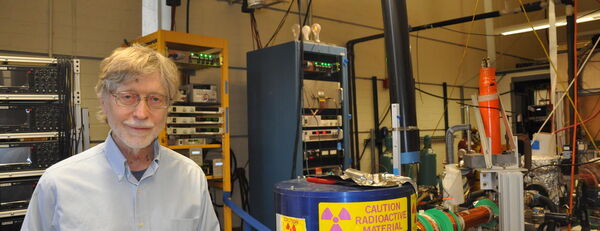
Gamma-ray laser moves a step closer to reality
"A physicist at the University of California, Riverside, has performed calculations showing hollow spherical bubbles filled with a gas of positronium atoms are stable in liquid helium. The calculations take scientists a step closer to realizing a gamma-ray laser, which may have applications in medical imaging, spacecraft propulsion, and cancer treatment. Extremely short-lived and only briefly stable, positronium is a hydrogen-like atom and a mixture of matter and antimatter — specifically, bound states of electrons and their antiparticles called positrons. To create a gamma-ray laser beam, positronium needs to be in a state called a Bose-Einstein condensate — a collection of positronium atoms in the same quantum state, allowing for more interactions and gamma radiation. Such a condensate is the key ingredient of a gamma-ray laser. “My calculations show that a bubble in liquid helium containing a million atoms of positronium would have a number density six times that of ordinary air and would exist as a matter-antimatter Bose-Einstein condensate,” said Allen Mills, a professor in the Department of Physics and Astronomy and sole author of the study that appears today in Physical Review A." [...]
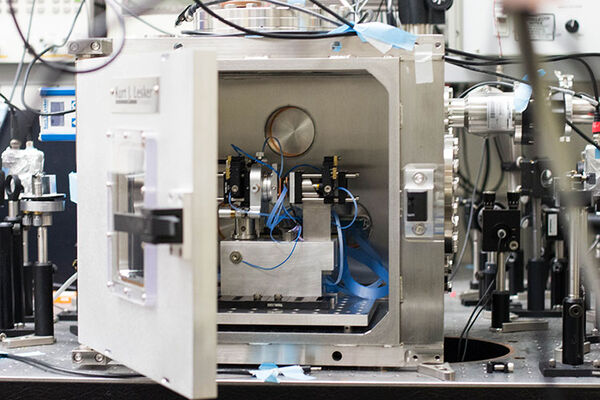
Heat energy leaps through empty space, thanks to quantum weirdness
"In a surprising new study, University of California, Berkeley, researchers show that heat energy can travel through a complete vacuum thanks to invisible quantum fluctuations. To conduct the challenging experiment, the team engineered extremely thin silicon nitride membranes, which they fabricated in a dust-free clean room, and then used optic and electronic components to precisely control and monitor the temperature of the membranes when they were locked inside a vacuum chamber. (UC Berkeley photo by Violet Carter) If you use a vacuum-insulated thermos to help keep your coffee hot, you may know it’s a good insulator because heat energy has a hard time moving through empty space. Vibrations of atoms or molecules, which carry thermal energy, simply can’t travel if there are no atoms or molecules around. But a new study by researchers at the University of California, Berkeley, shows how the weirdness of quantum mechanics can turn even this basic tenet of classical physics on its head. The study, appearing this week in the journal Nature, shows that heat energy can leap across a few hundred nanometers of a vacuum, thanks to a quantum mechanical phenomenon called the Casimir interaction." [...]
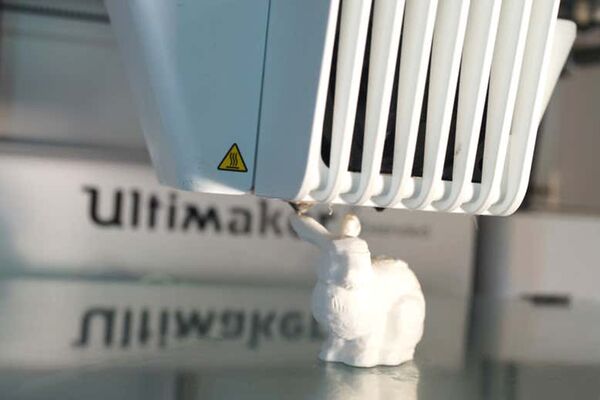
Storing data in everyday objects
"A research team with members from ETH Zurich has discovered a new method for turning nearly any object into a data storage unit. This makes it possible to save extensive data in, say, shirt buttons, water bottles or even the lenses of glasses, and then retrieve it years later. The technique also allows users to hide information and store it for later generations. It uses DNA as the storage medium. Living beings contain their own assembly and operating instructions in the form of DNA. That’s not the case with inanimate objects: anyone wishing to 3D print an object also requires a set of instructions." [...]
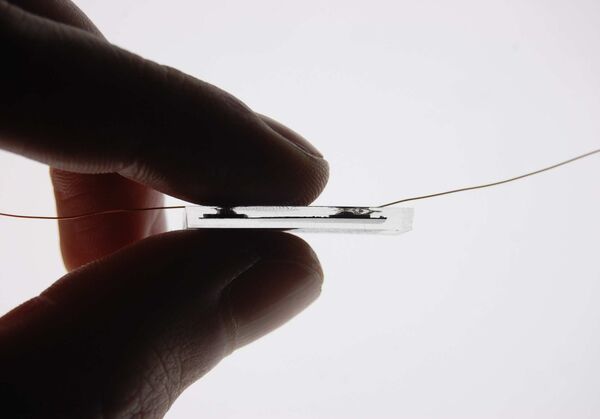
Stretchy and squeezy soft sensors one step closer thanks to new bonding method
"Imperial College London bioengineers have found a way to create stretchy and squeezy soft sensing devices by bonding rubber to electrical components. Stretchy and squeezy soft sensors that can fit around body parts or squeezed in hands could be used for applications including sports and rehabilitation after injury or stroke. For example, soft electrical force sensors in the form for a squeeze ball could monitor the rehabilitation of patients with hand injuries or neurological disorders. While such sensors have been in development for a long time, none have made it to market because they cannot easily be integrated with electronic components, like the wires, computer chips and batteries needed to gather, process and send the data the sensor collects. Now, a team of researchers from Imperial have invented a way to bond the stretchy and squeezy force-sensitive soft materials to electrical components. They have developed a bond so strong that the stretchy rubber itself breaks before the bond between the two different materials does." [...]
Modelos 3D
Com a disponibilidade de ferramentas que permitem dar azo a nossa imaginação na criação de peças 3D e espaços como o thingiverse para as publicar, esta rubrica apresenta alguns modelos selecionados que poderão ser úteis.

ESP-12E pogo pin programmer
"3d printed base for aligning pogo pins and mounting a serial module to allow programming of a bare ESP-12E module. Probably works for ESP-12F too. And others? " [...]

SMD Test clamp (LCR-T4)
"Cheap DIY SMD clamp (Meter Lead Probe) . For LCR-T4 IC Tester etc. Just attach two Dupont Connector Pins (Male) with wire. " [...]
Documentação
A documentação é parte essencial do processo de aprendizagem e a Internet além de artigos interessantes de explorar também tem alguma documentação em formato PDF interessante de ler. Todos os links aqui apresentados são para conteúdo disponibilizado livremente pelo editor do livro.
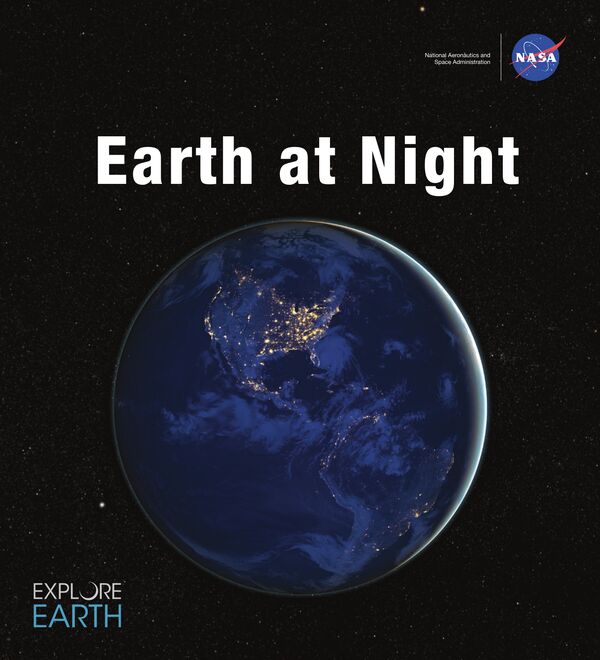
Earth at Night
"NASA’s Earth at Night explores the brilliance of our planet when it is in darkness. It is a compilation of stories depicting the interactions between science and wonder, and I am pleased to share this visually stunning and captivating exploration of our home planet. From space, our Earth looks tranquil. The blue ethereal vastness of the oceans harmoniously shares the space with verdant green land—an undercurrent of gentleness and solitude. But spending time gazing at the images presented in this book, our home planet at night instantly reveals a different reality. Beautiful, filled with glowing communities, natural wonders, and striking illumination, our world is bustling with activity and life." [...]
Projetos Maker
Diversos Projetos interessantes.

Add an IOT Lock to ANY Drawer!
"Hello! After quite a while I decided to share my latest project with all of you. This one was just an idea that I got after purchasing a cheap solenoid lock online, and it turned out to be a great project. So, basically the base idea was to make a secure (or at least secure-ish) spot for my stuff while I'm gone, or just a place to store stuff I don't want to misplace. I was originally thinking of maybe embedding some sort of RFID setup but I thought to myself: "Hey, you know what would be sick and unnecessary? Making the frickin' lock IOT!"." [...]

How to Convert Your Circuit Idea Into Printed Circuit Board (PCB)
"In this tutorial, we will learn the entire process of PCB Designing that is Printed Circuit Board, we will learn how to convert our electronic circuit Idea into a reality using EASYEDA and an online PCB manufacturing service. so follow up till the end to convert your idea from circuit to reality. Supplies: 1. Hardware - Computer. - Soldering Iron. - Soldering Wire." [...]
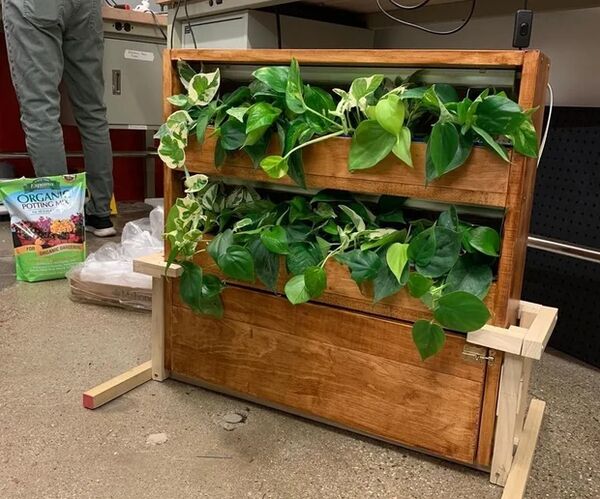
Self-sustaining Plant Wall
"Many busy professionals want to have plants in their home, but don’t have the time to maintain them. This self-watering planter maintains the plant by itself, requiring only a tank refill every other week. It waters the plants when the soil is dry, turns on the lights when the room is dark but the owner is awake and away, and signals when it runs low on water. Supplies: Case: - Wood finish Hinge (2 pack) - Latch (1x) - Screws (1 ½ and 1 ¾ inch) - 1x6 wood (3x, cut into 24 inch lengths) - 1x3 wood (1x, cut into 24 inch lengths) - Plywood (1x, 24”x24”) Tank: - Freezer ice cube tub - Planters & Plants: - Foamcore - Plastic - Tape - Soil Pothos plants (variety) Electronics: - 1 Arduino Uno - 1 breadboard (permanent is an option) - 2x LED Grow Light Strips (2/6 that come with that product) - 2x peristaltic liquid pump with silicone tubing - longer tubing - From Elegoo 37 Sensor Kit V2: - 1 Arduino water-level sensor - 1 Arduino photo-resistor - 1 I2C real-time clock (code assumes DS3231) - 1 5V relay - An additional 5V relay - 2 I2C soil-moisture sensors (Code assumes “Chirp!” brand.) - 1 controllable 4-outlet power relay - PC Power Connector, 6ft - Arduino power supply - Stacking Headers - Jumper Wires - Servo Extension Cables may be helpful - 1A Diodes - Wire (of sufficient gauge for your pump amperage draw) Tools: 3D printer; Soldering kit; Sander; Drill; Bandsaw; Hot glue gun; wire cutter" [...]
RGB LED Pixel Shades
"Hi everyone, in this Instructable I'm going to show you how to make a pair of LED pixel shades. Originally I created these to wear around the house at Christmas / New Years, sort of as a mobile ornament, but they ended up being a bit more cyberpunk than I anticipated, so they should be fun to wear at other events too! The shades use 76 WS2812b LEDs (aka Neopixels). The LEDs only project their light in one direction, so you can see through the shades without blinding yourself. WS2812b's are individually addressable, meaning that you control the color of each led. This lets you create almost any effect you can imagine (as long as you can code it)." [...]
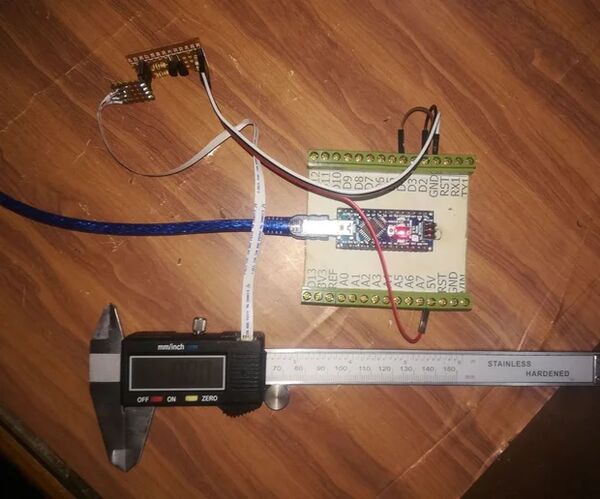
Hacked Digital Vernier Caliper Using Arduino
"So, what about doing some measurements with your Digital Vernier Caliper and having your Arduino to do some work with these measurements ? Maybe Saving them, Doing some based-on calculations or adding these measurements to a feedback loop from your mechanical device.In this instructable we're going to disassemble a Digital Vernier Caliper, hook some wires to it and interface the Caliper with the Arduino to display its measured values on the Arduino Serial Monitor. " [...]

Arduino Wedding Photo Booth - 3D Printed Parts, Automated and Low Budget
"I recently was invited to my partner's brother's wedding and they asked before if we could build them a photo booth as they cost too much to hire. This is what we came up with and after several compliments, I decided to turn it into an instructional project. So this is how to build your own Automated Photo Booth for less than hiring one (if you can lay your hands on a DSLR). You can customise the housing to suit your event/wedding and as it's controlled by an Arduino Nano you don't need anyone to 'man it' throughout the night. The guests just press the giant arcade button and the photo booth guides them through their own photoshoot sequence. :) Three photos are taken 10 seconds apart (you can change this in the code if you wanted to)." [...]

ASH: Anti-Facial Recognition Headgear
"Hello, this project will help you construct your own janky cyberpunk anti-facial recognition headset. This was inspired in part by many news stories of the last year about facial recognition that only reminds us about our impending dystopian future. Made for a school assignment, ASH is mostly a demonstration of several attempts at prototyping a facial recognition headset that by using LEDs can obscure the wearers face with the push of a button. Supplies: Here are some supplies you'll need: 1 large servo. a metal servo arm used in hobbyist RC vehicles. circuit playground and cricket." [...]
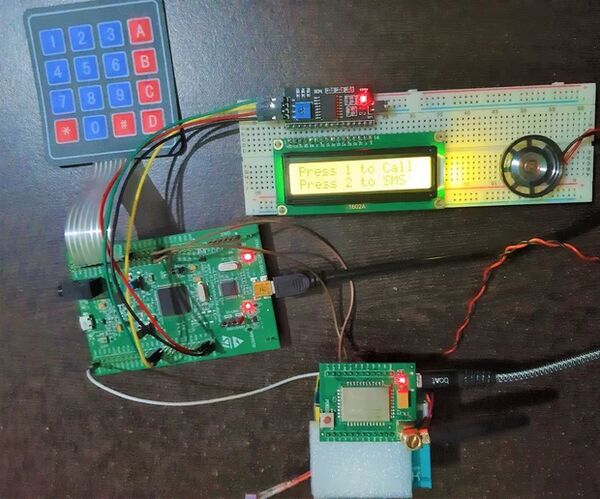
Basic Mobile Phone Using STM32F407 Discovery Kit and GSM A6 Module
"Have you ever wanted to create a cool embedded project?. If yes, how about building one of the most popular and everyone's favorite gadget i.e Mobile Phone!!!. In this Instructable, I will guide you on how to build a basic mobile phone using the STM32F407 Discovery Kit and GSM A6 module. This project contains 3 main modules : GSM A6 Module - This is module is responsible for Making/Receiving Calls and SMS. LCD 16x02 Display - To see the output Hex Keypad - To give input The STM32F407 MCU controls the GSM A6, LCD, and Keypad. So to make programming simple and organized, I developed individual driver code for Interfacing GSM A6 module, LCD and Keypad on STM32F407 MCU." [...]

DIY - Arduino Based Parking Assistant V2
"When life gives you bananas!!!!! Just eat them. Necessity is the mother of inventions, and I won't deny that fact. Frankly speaking, this is the 2nd time I bumped into our garage wall since we moved into this new house. That's it, there would be no third time. In this video, I am going to use an ultrasonic sensor to calculate the car's distance from the garage wall and display it using green, blue, yellow and red LEDs." [...]

Animation Coffee Table
"There are many very good instructables on how to make interactive coffee tables with LED matrices, and I took inspiration and hints from some of them. This one is simple, cheap and most of all it is meant to stimulate creativity: with just two buttons, you can create animations on it! We had an IKEA LACK table with a dent, bought a new one, leaving the old one up for reuse in a project. The top is 55x55x5cm, and it is hollow, with just a thin board on the top and bottom that is easy to cut through with a box cutter. The sides are more sturdy, made of ~1cm hardboard. It is filled with cardboard in a honeycomb structure, which is easily removed." [...]

Easy IOT Remotely Controlling ESP32 Using an Android App
"In this tutorial, we will write a DroidScript app to control a relay module using the ESP32 board over WiFi. Supplies: You will need: ESP32 board (we used ESP32_core_board_v2) An Android device The DroidScript app Arduino IDE Relay module Micro USB Cable Female to Female Jumper (Dupont) Connectors x3 WiFi" [...]
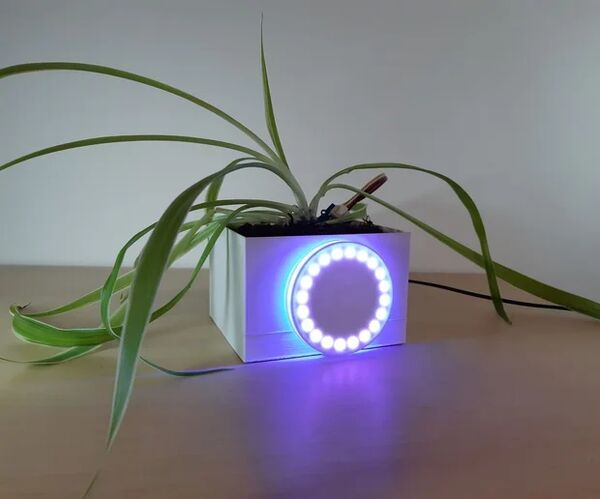
Connected Flowerpot by Micro:bit
"This flowerpot is made with 3D print and have a microbit card in it. This pot contains a micro: bit card housed under the soil container. This receives the information from the soil moisture sensor (conductivity). Transcription of the soil moisture value is done by means of a ring of 20 LED RGB (red, green, blue) programmable and located on the front. " [...]

Arduino MIDI Rhythm Section Sequencer
"Having a good software drum machine is easy and cheap today but using a mouse kills the fun for me. This is why I realized what initially was intended as a pure 64 steps hardware MIDI drum sequencer capable of triggering up to 12 different drum elements (parts), but then evolved in a rhythm section sequencer... ... there we go! This hardware cannot generate sounds on its own, but only sequence external hardware via MIDI. This means you will need a sound generator of your drum sounds (a sampler or a drum synthesizer or whatever you prefer) capable of being triggered by MIDI note-on messages. It's mainly composed by a 4 x 4 buttons matrix (with LEDs), one for each step of a bar. The whole 64 steps sequence is made up by 16 steps multiplied 4 bars." [...]
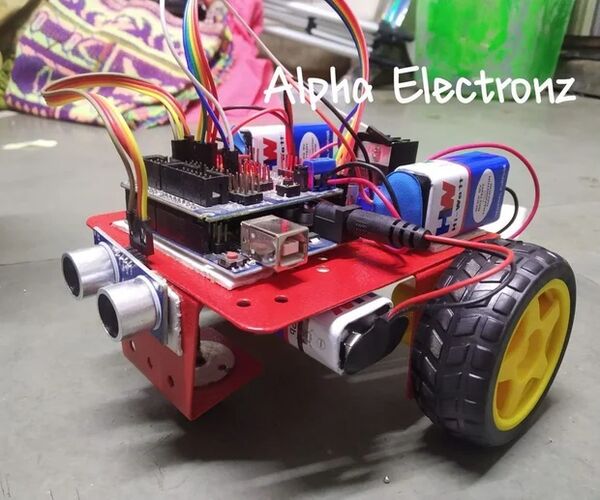
Obstacle Avoiding Bot Using Ultrasonic Sensor and Arduino
"In this tutorial we are going to make an obstacle Avoider Bot using Ultrasonic Sensor and Arduino Uno. Components Required - Arduino Uno - Ultrasonic sensor - L298N Motor Driver - 2x DC Motor - Chassis - Jumpers" [...]

Arduino RFID Reader With TFT Display
"I will show you in this instructable how to design a nice looking RFID reader with TFT display and for wall mounting. It is very easy to create a nice looking RFID reader with TFT output for wall mounting with an Arduino MKR of your choice and our ArduiTouch MKR kit. You can use this reader for door access or intruder alarm terminals. It's easy to extend this simple design for more complex applications and wireless data transmission. " [...]

Tekno'myd Helmet
"I recently learned how to code using an Arduino Uno, and I had this great idea for a helmet prop, with eyes that follow where the head is looking. So I dug around and found an accelerometer and a grid of color changing pixels, and started drawing up plans. what resulted was a sinister, yet goofy looking pyramid helmet. Here is how you make one for yourself! Supplies: - one (1) Arduino Uno and USB cord - one (1) L3G4200 triple axis gyro (available at MPJA.com, or anywhere these types of modules can be sold) - one (1) Adafruit 16x32 neopixel grid - one (1) Adafruit Arduino shield for the 16x32 neopixel grid AND stackable connectors(sold separately) - one (1) 9 volt battery or a small cellphone battery booster (check the MAH on your battery, the higher that number, the longer your battery will last) - Soldering equipment (Soldering pen, sponge, and solder) - two to three (2-3) Large sheets of black poster board (the cardboard-y kind. you are constructing the helmet out of the stuff, so pick something that feels sturdy) - glue, Elmers is fine since we are using plaster board - velcro strips - x-acto or box cutter knife - any and all appropriate resistors and wires for wiring an Arduino and a red LED (You can normally get these in a large bundle in a bunch of colors (I recommend MPJA.com to find these, you can normally get a good deal on shipping) - guts and determination." [...]
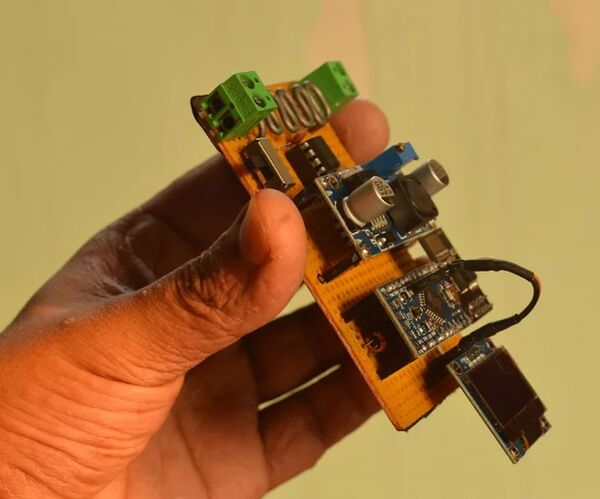
IoT Power Module: Adding an IoT Power Measurement Feature to My Solar Charge Controller
"Hello everyone, I hope you all are great! In this instructable I am going to show you how I made an IoT Power Measurement module that calculates the amount of power generated by my solar panels, that is being utilized by my solar charge controller to charge my lead acid battery pack. This module goes in between the solar panels and the charge controller and gives you all the necessary parameter details on your phone via the Internet. For the IoT platform I have used Blynk, which is very easy to use and can be easily customized as per your project. The limitation of the existing charge controller was that it only gave me the charging voltage and therefore the amount of power could not be determined. In this project I have added the voltage and current measurement functions to the power module which can be used to calculate power(in watts) and thus the total energy harvested." [...]

Embedded LED 3D Printed Christmas Tree
"This is a 3D-printed Christmas tree with embedded addressable LEDs inside. So it is possible to program the LEDs for nice light effects and using the 3D printed structure as a diffusor. The tree is separated in 4 stages and a base element (the tree trunk) to make it easier to assemble and embed the LEDs during the prints. So in total 5 elements have to be printed. LEDs are part of the print, they are not removable afterwards. Please ensure that everything works before embedding them into the print 3D files were designed in Fusion360 and are available at prusaprinters.org Supplies: - Transparent and green filament (In this case PLA filament was used) - Teensy M0 or other small Arduino board (Trinket M0) - Single Cell LiPo, for example a 18560 from Adafruit (battery) - ON/OFF Switch with 17.5 mm hole distance - 25 WS2812B LEDs - Coated Copper wire or other thin wires - Files at https://www.prusaprinters.org/prints/13643" [...]
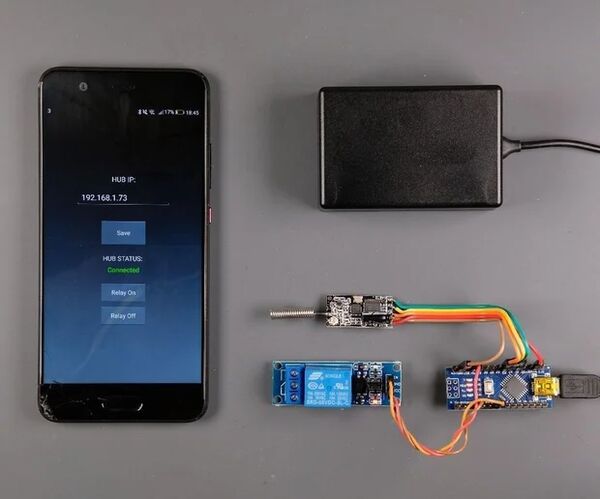
Easy IOT - Remote Controlled Relay Node
"For our first controllable device, we will use an Arduino Nano connected to a relay module and another HC-12 Module to receive the radio data from our ESP32 Hub. Once again, these parts are very cheaply obtainable from Amazon and eBay and the whole node can be built for well under 10 dollars from the right sellers. The diagram shows the components and connections we will be using. An example use of this kind of setup could be to control a garage door opener, an outdoor light or heater. Supplies: - Arduino Nano (or clone) - HC-12 Module - Relay Module - Female to Female Dupont Wires - Mini USB cable (or micro depending on the board)" [...]
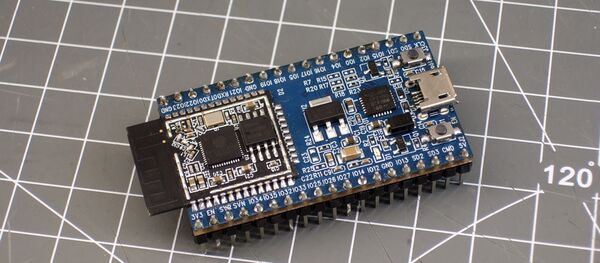
Working with ESP32 Audio Sampling
"The ESP32 is a next-generation, WiFi- and Bluetooth-enabled microcontroller. It’s Shanghai-based Espressif’s successor of the very popular—and, for the hobbyist audience, revolutionary—ESP8266 microcontroller. A behemoth among microcontrollers, the ESP32’s specs include everything but the kitchen sink. It is a system-on-a-chip (SoC) product and practically requires an operating system to make use of all its features. This ESP32 tutorial will explain and solve a particular problem of sampling the analog-to-digital converter (ADC) from a timer interrupt. We will use the Arduino IDE." [...]

BtleJack: a new Bluetooth Low Energy swiss-army knife
"Btlejack provides everything you need to sniff, jam and hijack Bluetooth Low Energy devices. It relies on one or more BBC Micro:Bit. devices running a dedicated firmware. You may also want to use an Adafruit's Bluefruit LE sniffer or a nRF51822 Eval Kit, as we added support for these devices. Current version of this tool (2.0) supports BLE 4.x and 5.x. The BLE 5.x support is limited, as it does only support the 1Mbps Uncoded PHY and does not support channel map updates." [...]
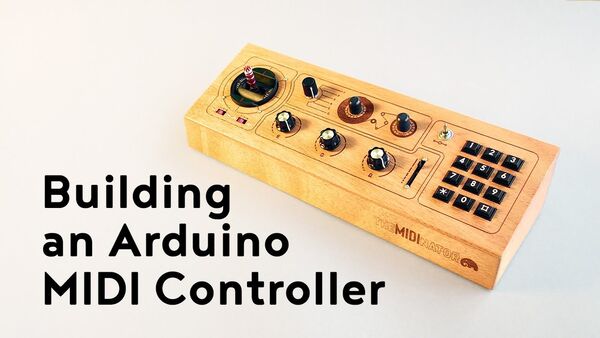
theMIDInator
"TheMIDInator is a MIDI controller based on an Arduino MEGA 2560. It uses a few potentiometers, rotary encoders, a joystick, switches and a keypad as inputs and sends MIDI commands via serial USB interface to the computer. For this controller to work properly a program such as Hairless MIDI to Serial Bridge needs to be running on the computer to receive the commands. This can then be piped into your DAW of choice. " [...]
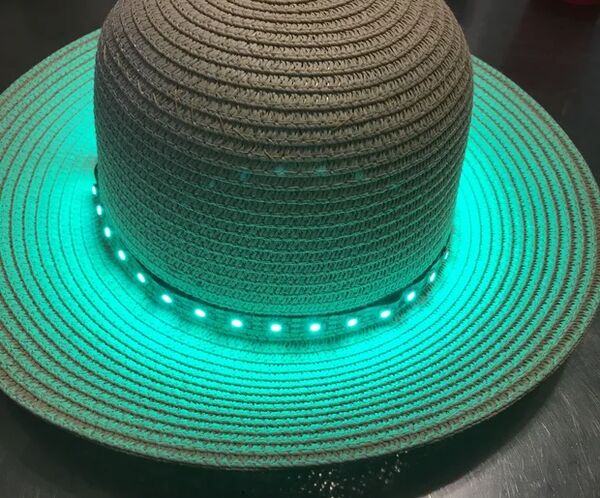
Arduino Buzzer/Light Temperature Alert Hat Prototype
"Part 1. This is somewhat of a part 2 of my original prototype instructable, found here. This is how to make the final hat product that the original was building up to. If you'll see in the original, we made a PCB board with a buzzer and attached it to a light strip. A very basic code would cause a light to flash and the buzzer to alarm when the temperature went past a certain threshold. That was my first instructable, and therefore this is my second." [...]
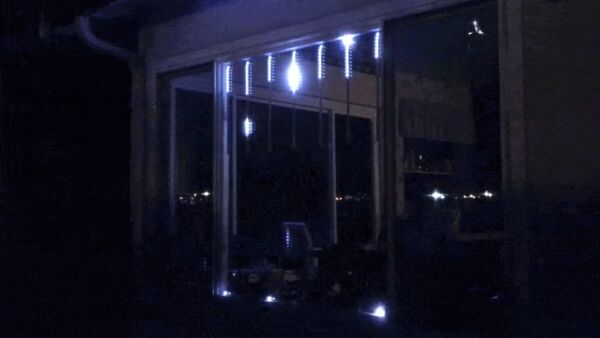
Holiday Icicle Lights with Flair
"I adore most anything with LEDs, but found those store-bought icicle or meteor lights a bit lacking. Nature rarely moves in straight lines and perfect intervals! In this project we’ll make our own, applying some basic physics for an eye-catching drip effect. PLUS…these have a built-in magic trick, making a “splat” where they hit the ground! This is a remix of an earlier project: the OOZE MASTER 3000 from Halloween…mostly it’s just larger now and uses different NeoPixel strips, and fits in a window rather than squeezing in a confined space. The code and principles are similar enough that you’d do well to skim that guide." [...]
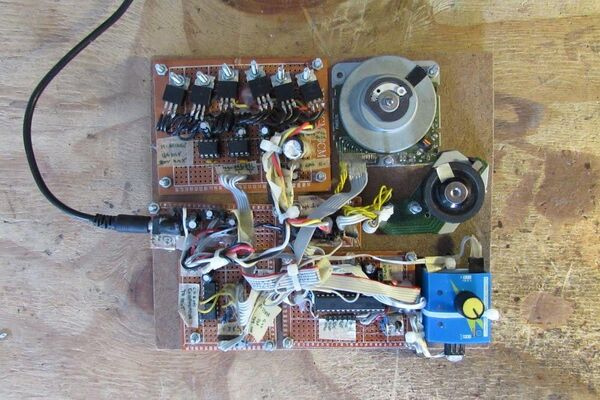
An ATmega brushless sensorless motor driver v02
"Brushless electric motor (BLDC motors) are synchronous motors that are powered by a DC electric source via an integrated inverter/switching power supply, which produces an AC electric signal to drive the motor. For an introduction to BLDC motors, you can take look at my sensored motor driver post, here: http://davidegironi.blogspot.it/2013/09/a-simple-brushless-sensored-motor.html or you can browse the internet, you will find there is a lot of litterature about BLDC motors. This library implements a brushless sensorless motor dirver for AVR ATmega. To write this library I take inspiration from the library above: This library take inspiration from: http://davidegironi.blogspot.it/2013/09/a-simple-brushless-sensorless-motor.html: my previous project on sensorless brushless motors http://davidegironi.blogspot.it/2013/09/a-simple-brushless-sensored-motor.html : my previous project on sensorled brushless motors http://www.atmel.com/images/doc8012.pdf : AVR444 Application note - Sensorless control of 3-phase brushless DC motors https://github.com/tobylockley/qut-brushless-controller : a brushless driver by Toby Lockley The code i propose is written, tested and compiled using avrgcc over an ATmega8 running at 16Mhz. I've also tested a version of this code on ATmega8 running at 8Mhz. The aim of is project is to build a faily simple bldc driver one can embed and easly modify in order to meet their own needs." [...]
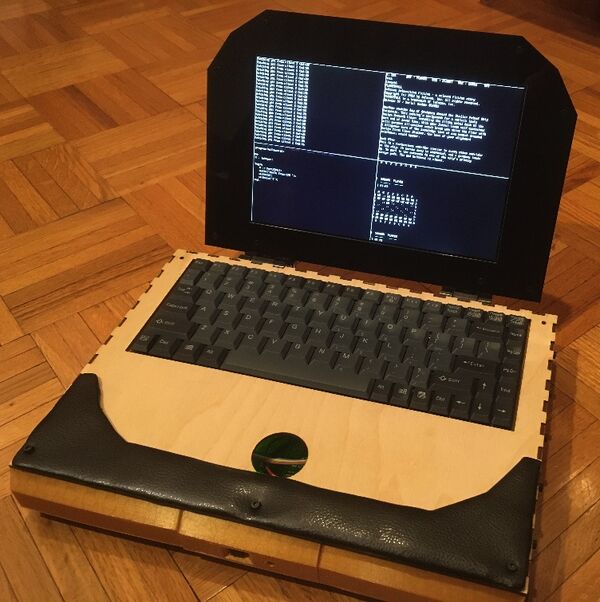
The ZedRipper: Part 1
"Meet the ZedRipper – a 16-core, 83 MHz Z80 powerhouse as portable as it is impractical. The ZedRipper is my latest attempt to build a fun ‘project’ machine, with a couple of goals in mind: Finally use one of the giant FPGA boards I had lying around Play a little ‘alternate-history computer engineering’ with a hardware-focused approach to multitasking Build a machine that I could write fun, small programs for on my daily train ride Build a platform that would allow for relatively easy computer-architecture experiments" [...]
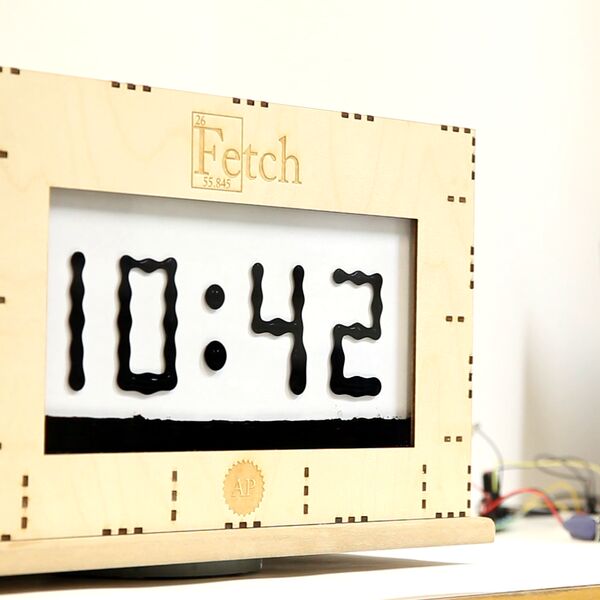
Fetch: A Ferrofluid Display
"A 252 electromagnet-matrix that controls Ferrofluid A student-project at the University of Oslo. We have designed and built a massive ferrofluid-display with 252 electromagnetic "pixels". The display has a 12x21 resolution (the closest we could get to 16:9 on our budget), and is not DONE. On Applied Procrastination we've shared all the details of this project and hope that it will inspire you to make something similar - or follow your own dream projects. Background We are a group of students at the University of Oslo, that have designed and built a massive ferrofluid-display with 252 electromagnetic "pixels". The display has a 12x21 resolution (the closest we could get to 16:9 on our budget), and is currently in the final testing phase." [...]

FM Music Transmitter
"If you want your tiny FM transmitter circuit to transmit music instead of spying or eavesdropping, you would probably find the following design interesting. The proposed FM transmitter will allow combining a stereo input simultaneously from the source so that the info contained inside both the channels get into the air for an optimal reception. The stability of the transmitter is improved by tapping the antenna from one top turn of the coil as shown in the above circuit. This actually enhances the response of the circuits due to a couple of reasons. The antenna gets aloof from the collector of the transistor allowing it to function freely without unnecessary loading, and the slipping of the antenna to the top further allows the relevant side of the coil to get a higher stepped up voltage induced across itself and also the coil generating a higher concentration of transmission power on the antenna. Although this enhancement may not actual increase the range of the device, it makes sure that the circuit does not get rattled when hand held, or when the grip is encircled close over the circuit inside its enclosure." [...]
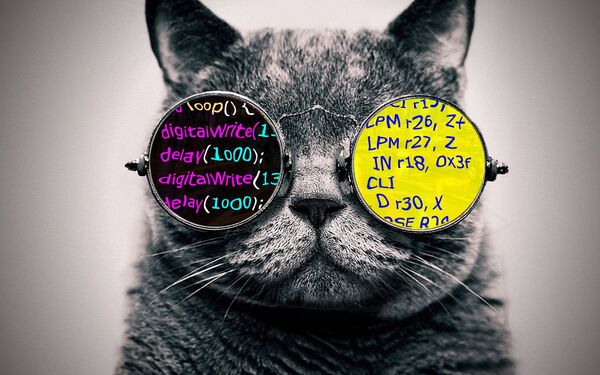
AVR8js: Simulate Arduino in JavaScript
"New AVR simulator that allows you to compile and run Arduino code directly in your browser! When I write about JavaScript or other Web-related topics, I often include code samples that you can run and interact with. This allows the readers to tinker with the code and experiment further, as well as test their understanding of the subject. I wanted to bring the same experience to my Arduino and electronics blog post. That's how AVR8js, an open-source AVR simulator that runs inside the browser, was born. Shall I take you for a quick tour of the simulator and tell you how I built it?" [...]
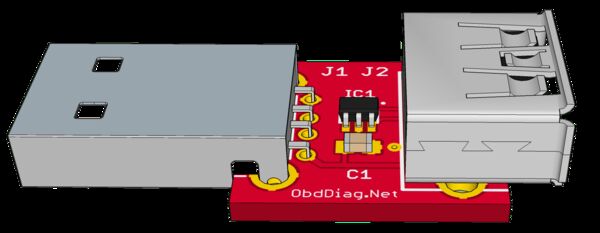
USB Charging Port Controller using TPS2514
"Texas Instrument’s USB Dedicated Charging Port Controller TPS2514 is specifically designed to implement the charging schemas mentioned below. An auto-detect feature monitors USB data line voltage and automatically provides the correct electrical signatures on D+ and D– data lines. Note that the chip datasheet never mentioned Samsung or Apple in particular apparently due to the copyright issues. Instead, it mentioned 1.2V mode and different Apple charging modes as Divider 1, Divider 2 and Divider 3. There are two modifications of the chip. TPS2514 has Dividers 1 and 2 for configuration #2 and #3 when TPS2514A only Apple Divider 3 for configuration #4." [...]
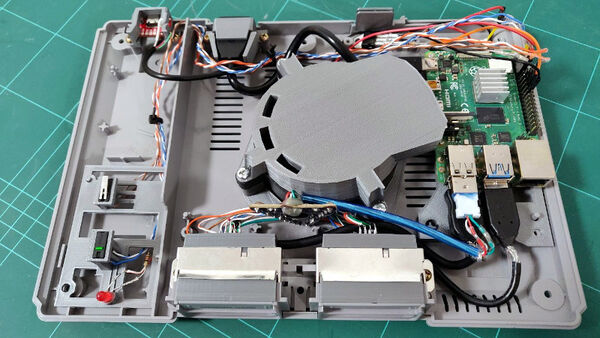
PSX Retropie
"My brother has always been a fan of the first Playstation. We've never had one in our family but we both grew up playing on our friends consoles. And even today both of us still love the low-fi style of the early 3D games released at that time. For the past year I've had an idea of giving him a Playstation 1 as a birthday gift but I wanted to take it a step further, make it a bit more modern internally; by converting it to a Raspberry Pi computer with a Playstation emulator. " [...]

Arduino Wristwatch
"This simple digital watch is inspired by the Eiriks Binary Wrist Watch from Sverd Industries! Check it out if you didn't already. Watch uses the same microcontroller as one on Arduino UNO - super hackable and easy to use! In this tutorial, I'll be showing how you can make your own programmable wristwatch - from the design process to sourcing parts, soldering and programming. Stick on and let's move forward! " [...]

PCBWay Arduino Bicycle Odometer
"Therefore, through this article, we will teach you how to assemble your distance calculation device using the reed switch sensor. Introduction In many vehicles, there are devices that calculate the distance traveled and are essential for presenting information to the driver. Thus, through this information, it is possible to monitor the distance traveled between two points, for example, through the vehicle odometer. Therefore, through this article, we will teach you how to assemble your distance calculation device using the reed switch sensor. The Project The following project was created to calculate the percorred distance by the bicycle of the gym. In addition, you'll learn how to create programming of the project." [...]
Watchmen's Sister Night NeoPixel Goggles
"In this project, we're building NeoPixel goggles inspired by HBO's television series Watchmen. Control the NeoPixel LED animations with a rotary encoder. Display up to four different modes with control like speed, colors and brightness of the NeoPixels. The 3D printed parts fit over costume goggles and snap fit together! The code was written in Circuit Python so it makes customizing much easier. This project uses the Trinket Adafruit M0 which is one of the tiniest boards supported in CircuitPython." [...]
NeoPixel Mini Cube
"This mini cube is made up of six 4x4 WS2812B panels giving a total of 96 individually addressable RGB LEDs. This mini cube is made up of six 4x4 WS2812B panels giving a total of 96 individually addressable RGB LEDs. Buried inside the cube is a ATtiny85 microcontroller powered by a 120mAh Lithium Ion battery. It also contains a mercury switch and a couple of transistors to turn the cube on. The cube switches itself off after displaying a series of animations. " [...]

Make your own light-up holiday sweater
"People use ugly sweater parties as opportunities to get creative: Some may find tacky sweaters while rummaging through their parents’ closets and browsing in thrift shops; others may craft their own with felt and a hot glue gun. Coming up with a ridiculous sweater is part of the fun. Still, you’ll find sweaters that are intentionally ugly. If you go to Amazon, you’ll find thousands of varieties, including meme-themed sweaters, and even one with Jesus breakdancing, for some reason. It makes dressing up easier, but it also takes a bit of the fun out of the occasion. This year, I wanted to create something unique, so I took an ordinary sweater and added a grid of lights programmed to make it look like it was snowing." [...]
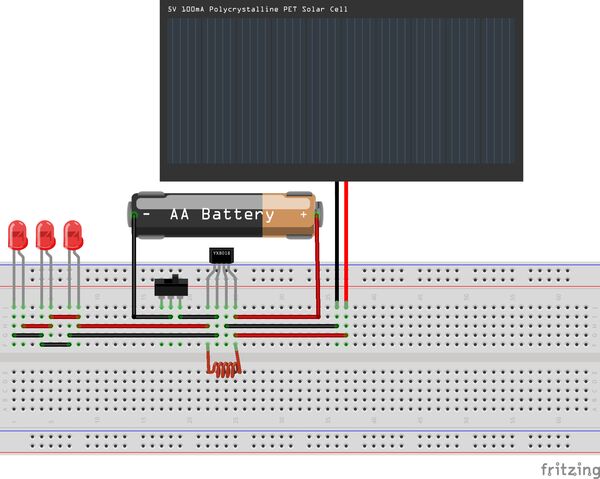
YX8018 Joule Thief Solar LED Driver
"YX8018 is a 4-pin integrated circuit for driving solar powered garden LED lights and is found on many cheap garden lights. You can buy 10x YX8018 ICs on AliExpress for around $1. You will need the following parts to build one on your own. Parts - i-Cd AA 300mAh 1.2v rechargable battery - YX8018 solar LED driver IC, TO-94 package - Solar panel, 5cm x 5.5cm - 3x white LED100 Microhenrys +/-10% inductor (brown black brown silver) - Switch" [...]

Overclocking of the Raspberry Pi 4
"Safe overclocking of the Raspberry Pi 4 to 2.1 GHz. Introduction. If one subject is surrounded by myths, it is overclocking. It would be dangerous and destroy your Raspberry Pi. This article provides the essential background, after which you can safely overclock the Raspberry Pi to 2.1 GHz. Theory." [...]
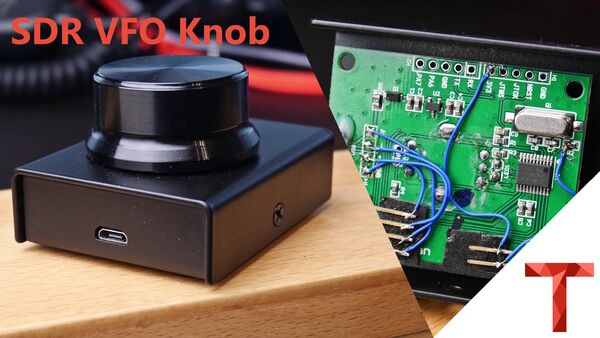
Reprogramming a Audio Knob to build a SDR VFO Knob
"I recently wanted to get a VFO knob to be able to better adjust the Frequency of my SDRs for SSB Signals on Shortwave or QO100 for example. You can use the Mouse Wheel on a PC, but on a Notebook or Tablet you are out of luck. After a quick Google Search i wasn't able to find anything like i wanted for a reasonable price, but i found a Audio Dial for only 15€ including Shipping on Ebay. I thought that for the price it was worth a try, even when there is no chance of changing the Audio control to something else, i at least will have a nice looking USB Knob with a metal Case and a Long micro USB Cable. After it arrive i first gave it a try on Controling the Audio on my PC and it worked nicely. The Base is quite heavy and has some rubber pads, so it stays in place very nicely." [...]

Stereo volume and balance control with Rotary Encoder using MAX5440
"The project described here is a compact stereo volume and balance control with rotary encoder. It provides 32 log potentiometer steps with buffered wiper output. The project can easily replace mechanical potentiometer. 5 LEDs indicate the volume level or balance settings , depending on the status of the mode indicator D1 LED. The MAX5440 includes debounced pushbutton inputs for mute and mode. The mute input allows a single pushbutton to change between volume control and the -90dB (typ) mute setting." [...]

A Smart Glove Computer Mouse
"This is a "Smart Glove" wearable computer mouse that can be used with any PC, Mac, or Linux computer. This is a "Smart Glove" computer mouse that can be used with any PC, Mac, or Linux computer. It's made using a Binho Nova multi-protocol USB host adapter, which lets you connect sensors and other components to your computer and then control them using code running on the computer (as opposed to programming a microcontroller). With this Smart Glove, you can move the mouse cursor around, left click, or right click. Dragging isn't currently programmed, but the mouse control library does support that functionality if you want to add it. This can be adapted for a number of assistive mouse devices, such as a headband for those who don't have use of their hands." [...]
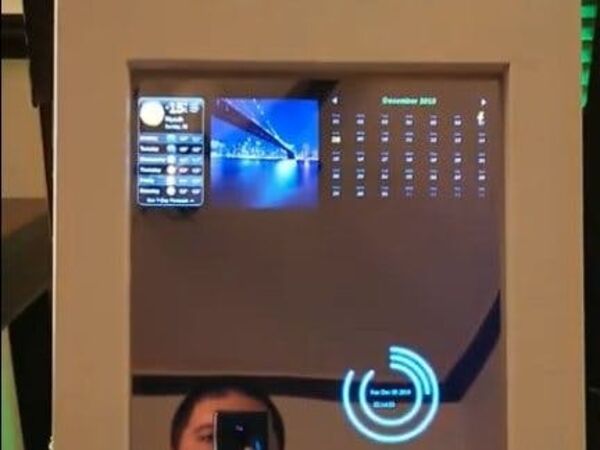
Smart Mirror
"A very basic yet very cool smart mirror which is easy to build and enhance. Why I built it? I have been watching smart mirrors over the web for last many years and had it in pipeline of my To Do. I researched many as how people are building it and what type of contents to be displayed. I played with many versions which were good but they were unable to impress me. So, I decided to build my own interface and design and add different flavors to it." [...]

Reverse engineering & hacking HerkuleX DRS-0602 servo
"You must be wondering why I’m “reverse engineering” this servo. The answer is pretty straightforward: someone in my scientific circle has damaged it by connecting the power supply to the wrong pins of the header. As you might have guessed it, the magic smoke has escaped immediately ! .Obviously we could just buy another one, but the main problem with that is: the cost. This servo costs around 320$ + shipping. Upssss , that hurts!" [...]

A Blooming Time
"A mechanical flower that will open when touched, you can tell the day from the petals, as well as the date, time, temperature and humidity. Introduction When I was young, I loved to play with plants, and one of my favourites is the mimosa plant, which will close when touched. However, in fantasy tales, flowers would open when they are touched, and I wanted to recreate this magical effect in my project. With the 1 year anniversary of my boyfriend and I nearing, I wanted to dedicate to him a special present that I made myself, hence the birth of this flower. As both of us are forgetful people, I wanted the flower to remind us of special days, with the flower lighting up in a colour for each important day. On each day of the week, one of the petals will light up, reminding you of the day of the week in a unique and fun way." [...]

Hacking a Luminator bus sign
"Use a RasPi to control a Luminator sign using Wifi Step-by-step instructions to reverse engineer and modify a Luminator bus sign, adding a Raspberry Pi for control over WiFi. The Port City Makerspace gifted our makerspace a pair of Luminator LED signs, the kind busses use to show route information, and I managed to reverse engineer the internal bus protocol. The sign lends itself well to control by an Arduino, or RasPi for control over wifi. Old bus signs are collectible, so here are the steps to reverse engineer and modify one. I've included programs to display images on the sign using a Raspberry Pi. With a wifi dongle, the sign can be remotely controlled." [...]
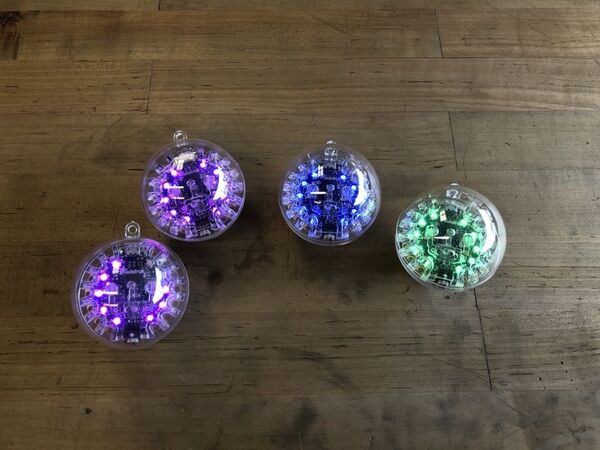
Bluefruit Playground Hide and Seek
"Stage a creative gift hunt all around your home with Bluetooth LE tracking ornaments! Circuit Playground Bluefruit boards can hone in on the proximity of other boards broadcasting their own signal including color coding! The stronger the signal, the more NeoPixels light up. All coded with CircuitPython. The more the merrier here! Get together with some friends or a whole classroom full of Circuit Playground Bluefruits." [...]
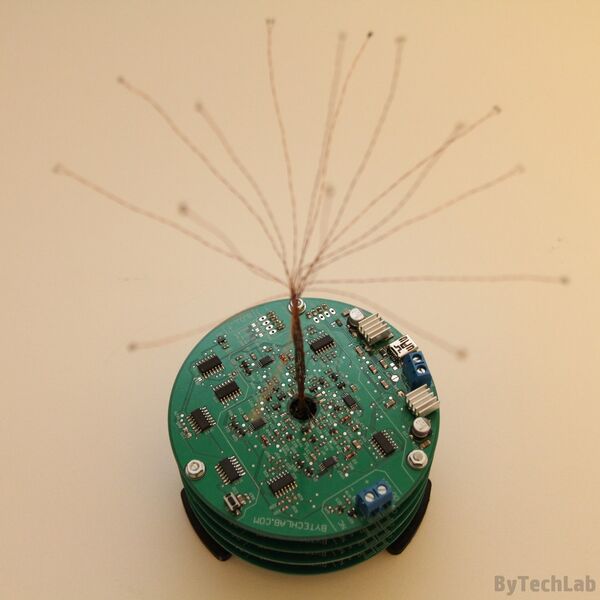
A LED tree that you can blow out
"You must be wondering why I’ve done this fancy and unusual project. The answer is pretty straightforward: I wanted to make “one of a kind” gift for my friend. Just something you can’t buy in a store , you know what I mean :). The LED tree from the electronics side is almost 100% analog, you know capacitors transistors and other stuff like that. Because of that I think its safe to say that it is the most complicated blinking LED circuit in the whole world (probably the biggest overkill I’ve ever done 😀 ). But you know, certainly this tree wouldn’t be so fun to build if I’ve used a μC." [...]

BubblesRNG
"BubblesRNG: A True Random Number Generator Using Air Bubbles As An Unconventional Source Of Entropy. This is the project I submitted for the final year while reading for a B.Sc. in Computing and Information Systems with the University of London. " [...]

Off-Grid Cyberdeck! The Raspberry Pi Recovery Kit
"Building Internet-connected things seems obvious today, but what about when there’s no Internet? The concept often feels like something out of a science fiction movie or a doomsday prepper’s handbook- and while this device can work in both scenarios, it’s also about understanding resiliency for your projects and being a good steward of the systems in place today. I’ve been posting the progress of this project on Instagram, Twitter, and Facebook all month, and this is my full build log of the project. You’ll find the parts list at the bottom of this article. They are affiliate links that help me make more cool stuff, and by using them you don’t pay any more than usual- so thank you for supporting my projects, even just a little bit. I posted about a month ago on my retrospective from four years ago when I made the Raspberry Pi Field Unit, which was generously shared on Hackaday then, and I posted a follow-up on Reddit several weeks back." [...]
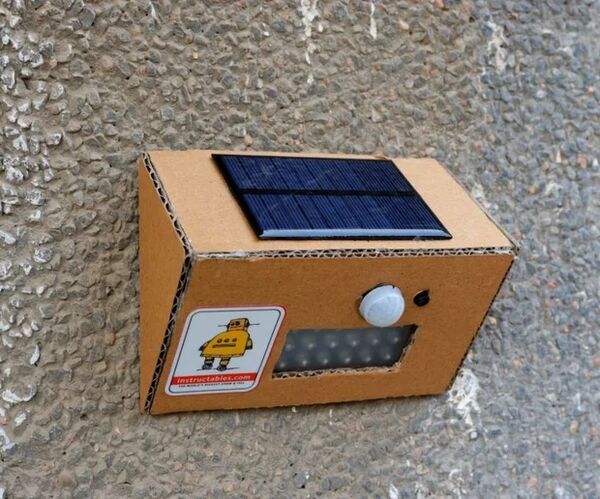
DIY Solar Motion Sensor Security Light
"Are you really concerned about safety in the surrounding areas of your house? If so, using solar-powered motion security lights can definitely help you!. You can get it easily in the market, but if you have a tight budget and curious to learn, then this project is definitely for you. In this Instructable, I'll guide you on how to make a solar-powered motion sensor LED light by using cardboard, few LEDs and a cheap controller board. The great advantage of this light is the combination of two of the most efficient and green technologies: LED and Solar. The light harvests solar energy during the day time and stores it in a Li-Ion battery for later use at night." [...]

Multi-Effects Internet Clock
"I have six red matrix LEDs in my warehouse, it seemed I bought them when I was a student about 15 years ago. It's surprising that theyre still in good condition. Today I'd like to share how to make by handmade an 16x24 led matrix - internet clock from these LED matrixes. It is controlled by ESP8266 NODEMCU with some cool effects..." [...]
That's all Folks!



